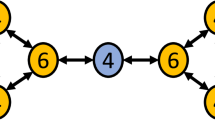Abstract
Handicap models of sexual selection predict that male sexual ornaments have strong condition-dependent expression and this allows females to evaluate male genetic quality1,2,3,4,5. A number of previous experiments have demonstrated heightened condition-dependence of sexual ornaments in response to environmental stress6,7,8,9. Here we show that genetic variation underlies the response to environmental stress (variable food quality) of a sexual ornament (male eye span) in the stalk-eyed fly Cyrtodiopsis dalmanni. Some male genotypes develop large eye span under all conditions, whereas other genotypes progressively reduce eye span as conditions deteriorate. Several non-sexual traits (female eye span, male and female wing length) also show genetic variation in condition-dependent expression, but their genetic response is entirely explained by scaling with body size. In contrast, the male sexual ornament still reveals genetic variation in the response to environmental stress after accounting for differences in body size. These results strongly support the hypothesis that female mate choice yields genetic benefits for offspring.
This is a preview of subscription content, access via your institution
Access options
Subscribe to this journal
Receive 51 print issues and online access
$199.00 per year
only $3.90 per issue
Buy this article
- Purchase on Springer Link
- Instant access to full article PDF
Prices may be subject to local taxes which are calculated during checkout


Similar content being viewed by others
References
Andersson, M. Evolution of condition-dependent sex ornaments and mating preferences: sexual selection based on viability differences. Evolution 40, 804–816 (1986).
Pomiankowski, A. Sexual selection: the handicap principle does work—sometimes. Proc. R. Soc. Lond. B 231, 123–145 (1987).
Grafen, A. Biological signals as handicaps. J. Theor. Biol. 144 , 517–546 (1990).
Iwasa, Y. & Pomiankowski, A. The evolution of mate preferences for multiple handicaps. Evolution 48, 853 –867 (1994).
Rowe, L. & Houle, D. The lek paradox and the capture of genetic variance by condition dependent traits. Proc. R. Soc. Lond. B 263, 1415–1421 ( 1996).
Hill, G. E. Proximate basis of variation in carotenoid pigmentation in male house finches. Auk 109, 1–12 (1992).
Gustaffson, L., Qvarnström, A. & Sheldon, B. C. Trade-offs between life-history traits and a secondary sexual character in male collared flycatchers. Nature 375, 311–313 (1995).
Hunt, J. & Simmons, L. W. Patterns of fluctuating asymmetry in beetles' horns: an experimental examination of the honest signalling hypothesis. Behav. Ecol. Sociobiol. 41, 109– 114 (1997).
David, P. et al. Male sexual ornament size but not asymmetry reflects condition in stalk-eyed flies. Proc. R. Soc. Lond. B 265, 1–6 (1998).
Burkhardt, D. & de la Motte, I. Big ‘antlers’ are favoured: female choice in stalk-eyed flies (Diptera, Insecta), field collected harems and laboratory experiments. J. Comp. Physiol. A 162, 649–652 (1988).
Wilkinson, G. S. & Reillo, P. R. Female choice response to artificial selection on an exaggerated male trait in a stalk-eyed fly. Proc. R. Soc. Lond. B 255, 1– 6 (1994).
Griffiths, S. C., Owens, I. P. F. & Burke, T. Environmental determination of a sexually selected trait. Nature 400, 358–360 (1999).
Qvarnstrom, A. Genotype-by-environment interactions in the determination of the size of a secondary sexual character in the collared flycatcher (Ficedula albicollis ). Evolution 53, 1564– 1572 (1999).
Wilkinson, G. S. & Taper, M. Evolution of genetic variation for condition-dependent traits in stalk-eyed flies. Proc. R. Soc. Lond. B 266, 1685–1690 (1999).
Lynch, M. & Walsh, B. Genetics and Analysis of Quantitative Traits (Sinauer Associates, Sunderland, Massachussetts, 1998).
Roff, D. A. Evolutionary Quantitative Genetics (Chapman & Hall, London, 1997).
Falconer, D. S. & Mackay, T. F. C. Introduction to Quantitative Genetics 4th edn (Longman, Harlow, 1996).
Acknowledgements
We thank T. Chapman and G. Hurst for comments, and A. Hingle for help in rearing fly stocks. This work was supported by Royal Society university research fellowships (K.F. and A.P.) and the NERC.
Author information
Authors and Affiliations
Corresponding author
Rights and permissions
About this article
Cite this article
David, P., Bjorksten, T., Fowler, K. et al. Condition-dependent signalling of genetic variation in stalk-eyed flies . Nature 406, 186–188 (2000). https://doi.org/10.1038/35018079
Received:
Accepted:
Issue Date:
DOI: https://doi.org/10.1038/35018079
This article is cited by
-
Strongly sexually dimorphic forelegs are not more condition-dependent than less dimorphic traits in Drosophila prolongata
Evolutionary Ecology (2023)
-
Sexual selection for males with beneficial mutations
Scientific Reports (2022)
-
Long horns protect Hestina japonica butterfly larvae from their natural enemies
Scientific Reports (2022)
-
Differences in energy source storage in eye stalks between two species of stalk-eyed flies, Sphyracephala detrahens and Cyrtodiopsis dalmanni
Scientific Reports (2022)
-
Molecular evidence supports a genic capture resolution of the lek paradox
Nature Communications (2019)
Comments
By submitting a comment you agree to abide by our Terms and Community Guidelines. If you find something abusive or that does not comply with our terms or guidelines please flag it as inappropriate.



